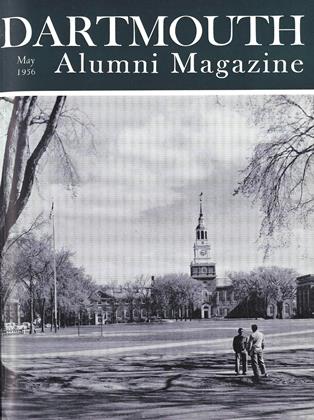Samuel M.Stayman '30. New York: Rinehart & Company, Inc. 1956. 223 pp. $3-95.
Probably most o£ the millions of routine bridge players believe that if they could see partner's hand and their own as a pictorial unit they would have very little trouble most of the time in choosing the best bidding action. Samuel Stayman, a champion of champions both nationally and internationally, shows clearly in the long awaited book of his complete system that they would not by any means be fully armed unless and until they understood the nature and use of weapons as yet unfamiliar to most of them.
Contract is still growing fast, very fast, and its possibilities of development are very far from being exhausted. The long period of honor-count was finally succeeded by the greater accuracy of point-count, but both before and after that radical change we have seen many years of gadgetry - endless attempts to sharpen existing bidding systems by special conventions, some fair and some not so fair. Mr. Stayman has evidently devoted much time and great ability, plus a keen inventive talent, to observing and analyzing all such material under the tests of actual play. As a top player he has had constant opportunity of discussion with the foremost players of America and Europe. For bridge players everywhere his most important conclusion has been that a group of special conventions tied onto honor-count or point-count did not provide a uniformly strong and reliable game.
Hence he concentrated on devising a complete and fully integrated bidding system, of which each part should be a logical part of a logical whole. And while building up he has been careful not to destroy. The reader wishing to benefit by his precise and complete method does not have to begin bridge all over again. The difference is that we can now have an expert of experts pointing out practical solutions to scores upon scores of bidding problems which we have formerly tried to handle by gamble or guesswork. The watchword in this new book is precision, and the countless illustrative sequences are clear and exact, omitting literally nothing in the artscience of bidding.
Many readers will be particularly interested in the advanced method of reaching slams; others in the sixteen ways of combining notrump bidding with suits; still others in the two dozen studies on doubling; yet again others in the widely detailed possibilities of defensive action. It is all there; and it provides not only the foundation, but the complete structure, of a winning bidding system.
 View Full Issue
View Full Issue
More From This Issue
-
 Feature
FeatureD C U
May 1956 By GEORGE H. KALBFLEISCH, -
 Feature
FeatureOliver Wendell Holmes Slept – and Taught – Here
May 1956 By ROBERT S. BLUM '55 -
 Feature
FeatureNEW YORK ALUMNI AWARDS
May 1956 -
 Class Notes
Class Notes1918
May 1956 By ERNEST H. EARLEY, RICHARD A. HOLTON -
 Class Notes
Class Notes1923
May 1956 By CHESLEY T. BIXBY, THEODORE D. SHAPLEIGH -
 Class Notes
Class Notes1926
May 1956 By HERBERT H. HARWOOD, ANDREW J. O'CONNOR, RICHARD EBERHART '26
Books
-
 Books
BooksA Study of Student Life-the Appraisal of Students Traditions
May 1935 -
 Books
BooksTHE PSYCHOLOGY OF SUCCESSFUL SELLING
July 1953 By C. L. STONE '17 -
 Books
BooksMISSION IN TORMENT: AN INTIMATE ACCOUNT OF THE U.S. ROLE IN VIETNAM.
JULY 1965 By ERNEST P. YOUNG -
 Books
BooksTHE ELECTRIC-LAMP INDUSTRY
December 1949 By H. L. Duncombe Jr. -
 Books
BooksALEXANDER POPE. ELOISA TO ABELARD WITH THE LETTERS OF HELOISE TO ABELARD IN THE VERSION
MAY 1966 By JOHN HURD '21 -
 Books
BooksCHRETIEN DE TROYES: INVENTOR OF THE MODERN NOVEL.
March 1958 By WILLIAM R. LANSBERG '38


